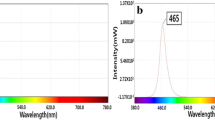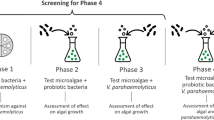Abstract
Antimicrobial photodynamic therapy (aPDT) uses light-specific wavelengths and nontoxic photosensitisers to eradicate target microbial cells. Bivalve hatchery systems are challenged with bacterial contamination of microalgae feed, which can be detrimental to all production life stages. The objectives of this study were to investigate the antimicrobial potential of blue LED and red laser aPDTs in a marine environment. The bacteria Vibrio spp. were targeted, as they have been associated with significant Pacific oyster Crassostrea gigas mortalities worldwide. The compartments tested were (a) microalgae feed (Tetraselmis sp., Isochrysis sp. and Chaetoceros muelleri) and (b) tank seawater. C. gigas seed-fed light-treated and untreated microalgae for 8 weeks were also screened for Vibrio spp. Molecular diagnostics (PCR, qPCR and Sanger sequencing) were used. The aPDTs were deemed non-destructive to the microalgae. V. splendidus was detected exclusively in C. muelleri growth cultures. Tank seawater samples were positive for V. splendidus pre-treatment. A complete eradication of V. splendidus RNA (indicative of pathogen viability) was observed in seawater samples treated by aPDTs, while no V. splendidus DNA (pathogen may be viable or not) was observed in seawater samples treated by red laser and a 33% reduction occurred when treated with LED. Of significance, a reduction of V. splendidus DNA and RNA was observed in oysters fed the aPDT-treated microalgae versus those oysters fed the untreated diet. This pilot study indicates that there is the potential to use aPDT to treat against pathogenic bacteria, in particular Vibrio spp., in hatchery microalgal feed and tank water.






Similar content being viewed by others
Availability of data and material
Raw data and material generated or analysed during this study are available at https://uccireland-my.sharepoint.com/:f:/g/personal/118224647_umail_ucc_ie/Eo0DTAaK_jhBqRgsYxwx8ogBSCmG5tBRUSYFpAhB39qGog?e=I2g6Au.
References
Abcam plc. (2020) Accessed 31 August 2020, URL: www.abcam.com/protocols/counting-cells-using-a-haemocytometer
Ablon G (2018) Phototherapy with light emitting diodes: treating a broad range of medical and aesthetic conditions in dermatology. J Clin Aesthet Dermatol 11(2):21–27
Aranguren R, Figueras A (2016) Moving from histopathology to molecular tools in the diagnosis of molluscs diseases of concern under EU legislation. Front Physiol 7:538
Araújo NC, Fontana CR, Bagnato VS, Gerbi MEM (2014) Photodynamic antimicrobial therapy of curcumin in biofilms and carious dentine. Lasers Med Sci 29(2):629–635
Astuti SD, Mahmud AF, Pudjiyanto M, Y., & Fitriyah, N. (2018) Antimicrobial photodynamic of blue LED for activation of curcumin extract (curcuma longa) on staphylococcus aureus bacteria, an in vitro study. J Phys Conf Ser 1120:012073. https://doi.org/10.1088/1742-6596/1120/1/012073
Bulit F, Grad I, Manoil D, Simon S, Wataha JC, Filieri A, Feki A, Schrenzel J, Lange N, Bouillaguet S (2014) Antimicrobial activity and cytotoxicity of 3 photosensitizers activated with blue light. J Endod 40(3):427–431
de Campos L, Migliorati CA, Simões A (2015) Antimicrobial photodynamic therapy in cancer patients. Lasers Dent:340–345
Carrera ET, Dias HB, Corbi SCT, Marcantonio RAC, Bernardi ACA, Bagnato VS, Rastelli ANS (2016) The application of antimicrobial photodynamic therapy (aPDT) in dentistry: a critical review. Laser Phys 26(12):123001
Cieplik F, Tabenski L, Buchalla W, Maisch T (2014) Antimicrobial photodynamic therapy for inactivation of biofilms formed by oral key pathogens. Front Microbiol:5
de Lorgeril J, Lucasson A, Petton B, Toulza E, Montagnani C, Clerissi C, Mitta G (2018) Immune-suppression by OsHV-1 viral infection causes fatal bacteraemia in Pacific oysters. Nat Commun 9(1)
del Prete MJ, Robles MS, Guio A, Martinez-A C, Izquierdo M, Garcia-Sanz JA (2002) Degradation of cellular mRNA is a general early apoptosis-induced event. FASEB J 16(14):2003–2005
Dubert J, Barja JL, Romalde JL (2017) New insights into pathogenic Vibrios affecting bivalves in hatcheries: present and future prospects. Front Microbiol 8
Elston RA, Frelier P, Cheney D (1999) Extrapallial abscesses associated with chronic bacterial infections in the intensively cultured juvenile Pacific oyster Crassostrea gigas. Dis Aquat Org 37:115–120
Falaise C, François C, Travers M-A, Morga B, Haure J, Tremblay R, Mouget J-L (2016) Antimicrobial compounds from eukaryotic microalgae against human pathogens and diseases in aquaculture. Marine Drugs 14(9):159
Fekrazad R, Bargrizan M, Sajadi S, Sajadi S (2011) Evaluation of the effect of photoactivated disinfection with Radachlorin® against Streptococcus mutans (an in vitro study). Photodiagn Photodyn Ther 8(3):249–253
Fimple JL, Fontana CR, Foschi F, Ruggiero K, Song X, Pagonis TC (2008) Photodynamic treatment of endodontic polymicrobial infection in vitro. J Endod 34:728–734
Freire F, Costa ACBP, Pereira CA, Beltrame Junior M, Junqueira JC, Jorge AOC (2013) Comparison of the effect of rose bengal- and eosin Y-mediated photodynamic inactivation on planktonic cells and biofilms of Candida albicans. Lasers Med Sci 29(3):949–955
Garnier M, Labreuche Y, Garcia C, Robert M, Nicolas J-L (2007) Evidence for the involvement of pathogenic bacteria in summer mortalities of the Pacific oyster Crassostrea gigas. Microb Ecol 53(2):187–196. https://doi.org/10.1007/s00248-006-9061-9
Gay M, Renault T, Pons A, Le Roux F (2004) Two Vibrio splendidus related strains collaborate to kill Crassostrea gigas: taxonomy and host alterations. Dis Aquat Org 62:65–74. https://doi.org/10.3354/dao062065
Gomez-Gil B, Roque A, Velasco-Blanco G (2002) Culture of Vibrio alginolyticus C7b, a potential probiotic bacterium, with the microalga Chaetoceros muelleri. Aquaculture 211(1–4):43–48
Gonzales FP, Felgenträger A, Bäumler W, Maisch T (2013) Fungicidal photodynamic effect of a two-fold positively charged porphyrin against Candida albicans planktonic cells and biofilms. Future Microbiol 8:785–797
Goulden EF, Høj L, Hall MR (2013) Microbial management for bacterial pathogen control in invertebrate aquaculture hatcheries. Advances in Aquaculture Hatchery Technology:246–285
Hu X, Huang Y-Y, Wang Y, Wang X, Hamblin MR (2018) Antimicrobial photodynamic therapy to control clinically relevant biofilm infections. Front Microbiol 9:1299
Jabeen A, Reeder B, Svistunenko D, Hisaindee S, Ashraf S, Al-Zuhair S, Battah S (2018) Effect of the photodynamic therapy applications with potent microalgae constituents on several types of tumor. IRBM. 40:51–61. https://doi.org/10.1016/j.irbm.2018.11.003
Kett GF, Culloty SC, Jansen MAK & Lynch SA (Unpublished) Development of a sensitive polymerase chain reaction (PCR) and DIG-labelled in situ hybridisation (ISH) for the detection of Vibrio bacteria
Kibenge FS (2019) Emerging viruses in aquaculture. Curr Opin Virol 34:97–103
Kwizera R, Akampurira A, Kandole TK, Nielsen K, Kambugu A, Meya DB, Boulware DR, Rhein J, ASTRO-CM Study Team (2017) Evaluation of trypan blue stain in a haemocytometer for rapid detection of cerebrospinal fluid sterility in HIV patients with cryptococcal meningitis. BMC Microbiol 17(1):182
Lacoste A, Jalabert F, Malham S, Cueff A, Gélébart F, Cordevant C, Lange M, Poulet S (2001) A Vibrio splendidus strain is associated with summer mortality of juvenile oysters Crassostrea gigas in the Bay of Morlaix (North Brittany, France). Dis Aquat Org 46:139–145. https://doi.org/10.3354/dao046139
Le Roux F, Wegner KM, Polz MF (2016) Oysters and Vibrios as a model for disease dynamics in wild animals. Trends Microbiol 24(7):568–580
Leite DP, Paolillo FR, Parmesano TN, Fontana CR, Bagnato VS (2014) Effects of photodynamic therapy with blue light and curcumin as mouth rinse for oral disinfection: a randomized controlled trial. Photomed Laser Surg 32(11):627–632
López-Sanmartín M, Catanese G, Grau A, Valencia JM, García-March JR, Navas JI (2019) Real-time PCR based test for the early diagnosis of Haplosporidium pinnae affecting fan mussel Pinna nobilis. PLoS One 14(2):e0212028
Lupo C, Travers M-A, Tourbiez D, Barthélémy CF, Beaunée G, Ezanno P (2019) Modeling the transmission of Vibrio aestuarianus in Pacific oysters using experimental infection data. Front Vet Sci 6. https://doi.org/10.3389/fvets.2019.00142
McCleary S, Henshilwood K (2015) Novel quantitative TaqMan® MGB real-time PCR for sensitive detection of Vibrio aestuarianus in Crassostrea gigas. Dis Aquat Org 114:239–248
McKillip JL, Jaykus LA, Drake M (1998) rRNA stability in heat-killed and UV-irradiated enterotoxigenic Staphylococcus aureus and Escherichia coli O157:H7. Appl Environ Microbiol 64(11):4264–4268
Nesi-Reis V, Lera-Nonose DSSL, Oyama J, Silva-Lalucci MPP, Demarchi IG, Aristides SMA, Lonardoni MVC (2018) Contribution of photodynamic therapy in wound healing: a systematic review. Photodiagn Photodyn Ther 21:294–305
Nocker A, Camper AK (2006) Selective removal of DNA from dead cells of mixed bacterial communities by use of ethidium monoazide. Appl Environ Microbiol 72(3):1997–2004
Orozco-Borbón MV, Valenzuela-Espinoza E, García-López JC (2014) Simultaneous growth of Chaetoceros muelleri and bacteria in batch cultures. Adv Microbiol 4:1025–1032
Park VY, Kim E-K, Lee HS, Moon HJ, Yoon JH, Kwak JY (2015) Real-time PCR cycle threshold values for the BRAFV600E mutation in papillary thyroid microcarcinoma may be associated with central lymph node metastasis. Medicine 94(28):e1149
Paschoal MA, Tonon CC, Spolidório DMP, Bagnato VS, Giusti JSM, Santos-Pinto L (2013) Photodynamic potential of curcumin and blue LED against Streptococcus mutans in a planktonic culture. Photodiagn Photodyn Ther 10(3):313–319
R Core Team (2013). R: A language and environment for statistical computing. R Foundation for Statistical Computing, Vienna, Austria. URL http://www.R-project.org/
Ricatto LGO, Conrado LAL, Turssi CP, França FMG, Basting RT, Amaral FLB (2014) Comparative evaluation of photodynamic therapy using LASER or light emitting diode on cariogenic bacteria: an in vitro study. Eur J Dent 08(04):509–514
Sampaio FJP, de Oliveira SCPS, Crugeira PJL, Monteiro JSC, de Araújo Fagnani SRC, Pepe IM, de Almeida PF, Pinheiro ALB (2019) aPDT using nanoconcentration of 1,9-dimethylmethylene blue associated to red light is efficacious in killing Enterococcus faecalis ATCC 29212 in vitro. J Photochem Photobiol B Biol 200:111654
Stentiford GD, Sritunyalucksana K, Flegel TW, Williams BAP, Withyachumnarnkul B, Itsathitphaisarn O, Bass D (2017) New paradigms to help solve the global aquaculture disease crisis. PLoS Pathog 13(2):e1006160
Street CN, Pedigo L, Gibbs A, Loebel NG (2009) Antimicrobial photodynamic therapy for the decolonization of methicillin-resistant Staphylococcus aureus from the anterior nares. In: Kessel DH (ed) Photodynamic therapy: back to the future. SPIE. https://doi.org/10.1117/12.828279
Strober W (2001) Trypan blue exclusion test of cell viability. Curr Protoc Immunol 21:A3.B1–A3.B2. https://doi.org/10.1002/0471142735.ima03bs21
Villela PA, de Souza N, C, de Baia JD, Gioso MA, Aranha ACC, de Freitas PM (2017) Antimicrobial photodynamic therapy (aPDT) and photobiomodulation (PBM – 660 nm) in a dog with chronic gingivostomatitis. Photodiagn Photodyn Ther 20:273–275
Walsh PS, Metzger DA, Higuchi R (1991) Chelex 100 as a medium for simple extraction of DNA for PCR-based typing from forensic material. Biotechniques 10:506–513
Weigel KM, Jones KL, Do JS, Melton Witt J, Chung J-H, Valcke C, Cangelosi GA (2013) Molecular viability testing of bacterial pathogens from a complex human sample matrix. PLoS One 8(1):e54886
Wood S, Metcalf D, Devine D, Robinson C (2006) Erythrosine is a potential photosensitizer for the photodynamic therapy of oral plaque biofilms. J Antimicrob Chemother 57(4):680–684
Zanin ICJ, Gonçalves RB, Junior AB, Hope CK, Pratten J (2005) Susceptibility of Streptococcus mutans biofilms to photodynamic therapy: an in vitro study. J Antimicrob Chemother 56(2):324–330
Funding
This study was funded by the VIVALDI project (Preventing and Mitigating Farmed Bivalve Diseases) and has received funding from the European Union’s Horizon 2020 Research and innovation programme under Grant Agreement No. 678589.
Author information
Authors and Affiliations
Contributions
All authors contributed in part to the conception and design of the study. Dean A. Notaro carried out the experiments, with the assistance of Sharon A. Lynch, to generate the data. Analysis and interpretation of the data were carried out by all authors. Dean A. Notaro wrote the original draft of the article while Sharon A. Lynch and Sarah C. Culloty reviewed, edited and contributed content up until the final draft of the article. All authors have been involved in the revised article and approve the version to be submitted.
Corresponding author
Ethics declarations
Conflict of interest
The authors declare that they have no conflict of interest.
Ethics approval and consent to participate
This study complies with institutional, national and international animal ethics guidelines and policy and was approved by the institutional ethics committee.
Consent for publication
The authors consent to the publication of this manuscript.
Code availability
Not applicable.
Additional information
Publisher’s note
Springer Nature remains neutral with regard to jurisdictional claims in published maps and institutional affiliations.
This article is part of the Topical Collection on Innovations in disease control and diagnosis
Rights and permissions
About this article
Cite this article
Notaro, D.A., Culloty, S.C. & Lynch, S.A. A pilot study investigating the potential of antimicrobial photodynamic therapy (aPDT) to control Vibrio spp. development in microalgae and seawater. Aquacult Int 29, 355–372 (2021). https://doi.org/10.1007/s10499-020-00631-z
Received:
Accepted:
Published:
Issue Date:
DOI: https://doi.org/10.1007/s10499-020-00631-z




